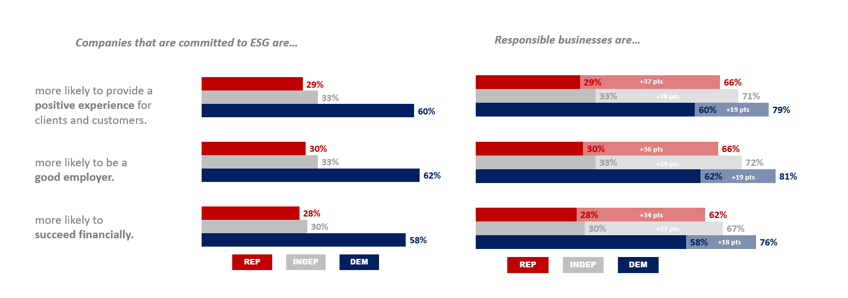ESG Has a Branding Problem

You’ve likely heard the phrase, “It’s not what you say; it’s how you say it.” This idea—in a nutshell—epitomizes the problem with how corporations position their environmental, social and governance (ESG) efforts. New research indicates that the general public supports the substance behind most ESG initiatives, but the terminology used to describe those efforts is often a turnoff.
In a recent study conducted by Maslansky + Partners, the language strategy firm found that while the acronym “ESG” is favorable among many respondents, overall support for the ideas behind “ESG” skyrockets when the term is absent from the discussion.

Source: https://maslansky.com/2023/11/14/the-language-of-esg-is-killing-esg/
However, it shouldn’t be assumed that the lukewarm response toward the use of “ESG” is attributable to a broad dislike of the term. The Maslansky study found that the average person may or may not even know what the acronym refers to, as only one in two respondents had even heard the term before. Additionally, only one in ten respondents admitted knowing “much” about what ESG represents.
Throw Out the Acronym but Not the Ideas
Twenty years after the term became mainstream, it’s clear we need to stop trying to make “ESG” happen. As society and culture evolve, language changes along with it, and “ESG” has proven to be an unpopular example of corporate jargon run amok.
While the acronym may be unpopular, the concept is not. In fact, Maslansky’s study found the following:
- 79% of respondents said that environmentally responsible companies are more likely to be financially successful
- 96% of respondents believe companies that take care of their employees are more likely to succeed financially
- 88% of respondents feel companies that hold their leaders accountable are more likely to see financial success
As the data show, the ideas behind the three pillars of ESG have broad support, so brands should continue to showcase how they are addressing these issues.
Position Your ESG Initiatives in a Way that Resonates
The first rule of communicating your ESG initiatives is you do not talk about “ESG.” For skilled communicators, using the right language is an effective way to get buy-in for a complex or controversial idea without misleading the audience. Because the terminology of ESG has proven to be alienating to many, it’s essential to discard the jargon in favor of putting the substance of your brand’s ESG strategy front and center.
Here are three ways to frame various ESG efforts to help ensure your message gets a positive reception:
Focus on Measurable Sustainability Improvements
The effects of a warming climate impact us all, so everyone has skin in the game to improve and protect the environment. Brands have to thread the needle between showing how they’re reducing their carbon footprint and not overpromising to the point of being seen as “greenwashing.”
Brands considered the most environmentally sustainable outline specific, measurable actions they’ve taken to reduce waste and lower their greenhouse gas emissions. On the other hand, brands accused of “greenwashing” announce vague sustainability goals without detailing how they plan to accomplish them.
Also, if possible, emphasize how your organization’s environmental goals will improve the bottom line. Even sustainability skeptics can’t argue against a company doing what’s best for its financial interests.
Exhibit Strong Support for Your Employees
If your employees feel supported, they can become your biggest advocates and phenomenal brand ambassadors. Showing goodwill towards your employees can generate more positive news stories and have a greater impact than hiring influencers or other spokespeople to promote your brand.
Customers love to do business with companies that are known to treat their employees well. It makes them feel good to give their hard-earned money to companies that align with their values. Give them another reason to feel proud to be your customer.
Demonstrate Responsible Leadership
With the rapidly growing influence of artificial intelligence (AI), the role of corporate governance in organizations is drawing increased scrutiny. Trust among the citizens of Western companies toward business institutions is relatively low, so corporations already have an uphill climb to win favor.
Maintaining a consistent cadence of communicating how your company governs is imperative to being seen as transparent and accountable. Regularly announcing leadership changes or company structure updates in a press release can go a long way. As the saying goes, it’s always better to play offense than defense.
The Takeaway
For your message to resonate, you need to meet your audience where it is. Even though your organization and its investors have a comprehensive understanding of “ESG,” that doesn’t mean your customers or prospects will. By centering the substance behind your ESG strategy and avoiding potentially problematic ESG language, your message will be more palatable to a broader audience.
See How PR Newswire Can Take Your Story to the Next Level
About the Author
 Erin Payton is the Integrated Customer Marketing Manager for PR Newswire. In her role, she develops multichannel marketing campaigns, drives demand generation, fosters brand awareness and creates thought leadership. Away from the keyboard, she is an unabashedly enthusiastic cat mom to Mia.
Erin Payton is the Integrated Customer Marketing Manager for PR Newswire. In her role, she develops multichannel marketing campaigns, drives demand generation, fosters brand awareness and creates thought leadership. Away from the keyboard, she is an unabashedly enthusiastic cat mom to Mia.